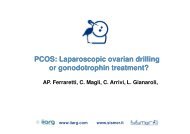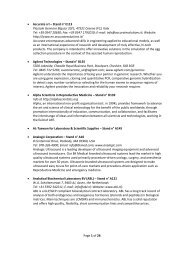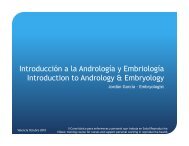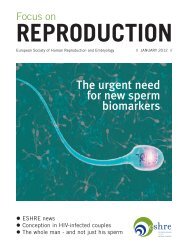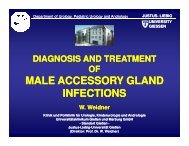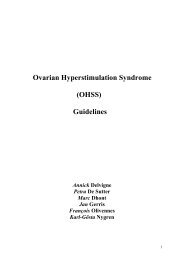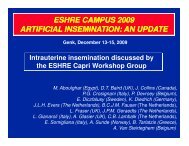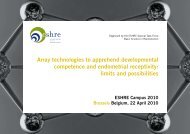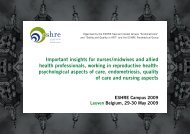Good Clinical Treatment in Assisted Reproduction - An ESHRE ...
Good Clinical Treatment in Assisted Reproduction - An ESHRE ...
Good Clinical Treatment in Assisted Reproduction - An ESHRE ...
You also want an ePaper? Increase the reach of your titles
YUMPU automatically turns print PDFs into web optimized ePapers that Google loves.
4. Women with hyperprolact<strong>in</strong>aemia should be offered treatment with dopam<strong>in</strong>e agonists such asbromocript<strong>in</strong>e or carbegol<strong>in</strong>e after check<strong>in</strong>g for thyroid function and correct<strong>in</strong>g any anomalies.INTRAUTERINE INSEMINATION (IUI)Although IUI represents a “mild” ART procedure, it must be performed with care, accord<strong>in</strong>g to strict criteria.Tubal patency as well as semen quality must be checked prior to perform<strong>in</strong>g IUI.There is general agreement <strong>in</strong> the literature that chances of success are better after mild ovarian stimulation andthe maturation of a maximum of two or three follicles. However, the cycle must be monitored by ultrasound andhormonal analysis; if there are more than three mature follicles, the attempt should be cancelled. While theconcurrent use of ovarian stimulation may <strong>in</strong>crease pregnancy rates, it may be at the expense of a high chanceof multiple pregnancy.The majority of pregnancies occur dur<strong>in</strong>g the first six cycles. In any case, the number of attempts should notexceed n<strong>in</strong>e cycles. When assess<strong>in</strong>g the duration of an IUI programme, the age of the woman must be taken <strong>in</strong>toaccount, to ensure timely transfer to more complex treatments if <strong>in</strong>dicated.IN VITRO FERTILISATION (IVF)Bilateral lack of tubal permeability represents an absolute <strong>in</strong>dication for perform<strong>in</strong>g IVF. Other <strong>in</strong>dications<strong>in</strong>clude doubtful tubal patency, endometriosis, moderate alterations of semen characteristics, unexpla<strong>in</strong>ed<strong>in</strong>fertility or failure of several previous cycles of ovulation <strong>in</strong>duction or IUI. IVF must be offered as a first‐l<strong>in</strong>etreatment <strong>in</strong> women of advanced maternal age, irrespective of the cause of <strong>in</strong>fertility. Conventional IVF shouldnot be proposed <strong>in</strong> the presence of severe sperm abnormalities, or after several fertilisation failures <strong>in</strong> previousattempts.INTRACYTOPLASMIC SPERM INJECTIONS (ICSI)ICSI should be considered <strong>in</strong> the presence of severe sperm abnormalities or a history of fertilisation failure <strong>in</strong>conventional IVF attempts. It must be emphasised that ICSI does not represent the most suitable treatment forfemale pathologies such as poor ovarian response or previous implantation failures.CRYOPRESERVATIONGiven that excess embryos are usually obta<strong>in</strong>ed dur<strong>in</strong>g IVF/ICSI treatments, the cryopreservation of embryosshould be rout<strong>in</strong>ely available as an <strong>in</strong>tegral part of <strong>in</strong>fertility services. The establishment of a successfulcryopreservation programme will <strong>in</strong>crease cumulative live birth rates and also make s<strong>in</strong>gle embryo transfer an<strong>in</strong>creas<strong>in</strong>gly efficient option. With a higher number of elective s<strong>in</strong>gle embryo transfer cycles, more good qualityembryos are available for cryopreservation. Cryopreservation not only makes these embryos available for futureuse by the couple, but may also be useful <strong>in</strong> avoid<strong>in</strong>g the risks of ovarian hyperstimulation.MULTIPLE PREGNANCIESThe most common complication of ART is multiple pregnancy. Maternal morbidity and mortality <strong>in</strong> multiplepregnancies are significantly <strong>in</strong>creased when compared to s<strong>in</strong>gleton pregnancies. Tw<strong>in</strong>s are associated withhigher rates of per<strong>in</strong>atal complications. The risk of neurological problems <strong>in</strong> newborns, cerebral palsy <strong>in</strong>cluded, ishigher than <strong>in</strong> s<strong>in</strong>gletons. Tw<strong>in</strong> pregnancies are <strong>in</strong>creas<strong>in</strong>gly accepted as a serious complication of ART for thecouple, the newborn and society.The decl<strong>in</strong>e <strong>in</strong> the number of multiple births can be regulated only with a reduction of the number of embryostransferred. This restrictive embryo transfer policy could be accepted as the only means of elim<strong>in</strong>at<strong>in</strong>g highorder multiple gestations. Although the transfer of two embryos has prevented triplet pregnancy, tw<strong>in</strong>pregnancies still account for more than ~25% of deliveries after two early stage embryos are transferred or morethan ~35% when two blastocysts are transferred.




